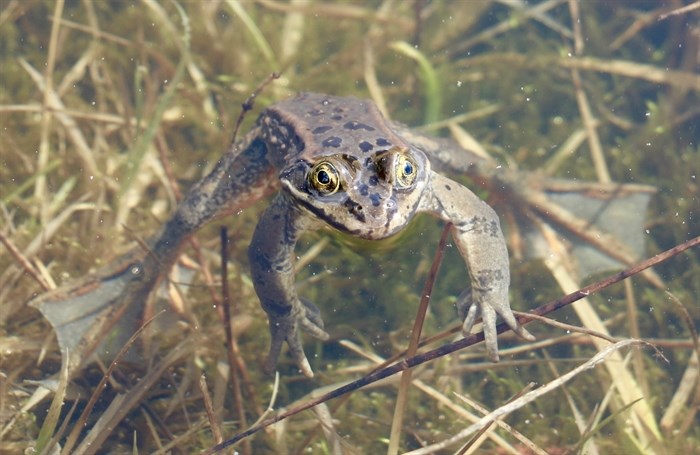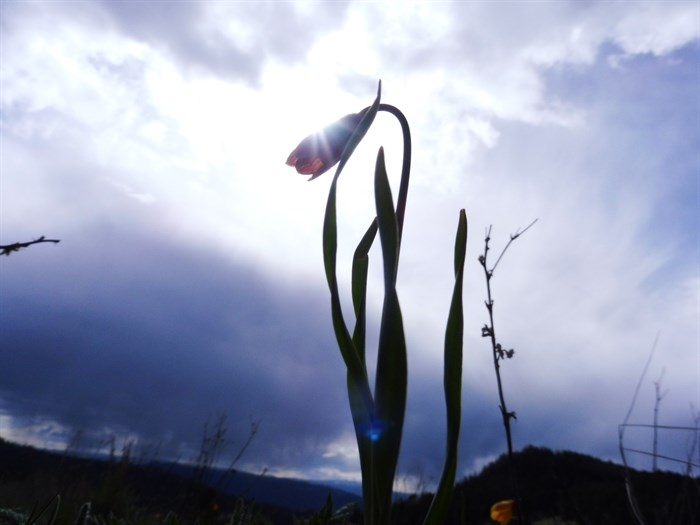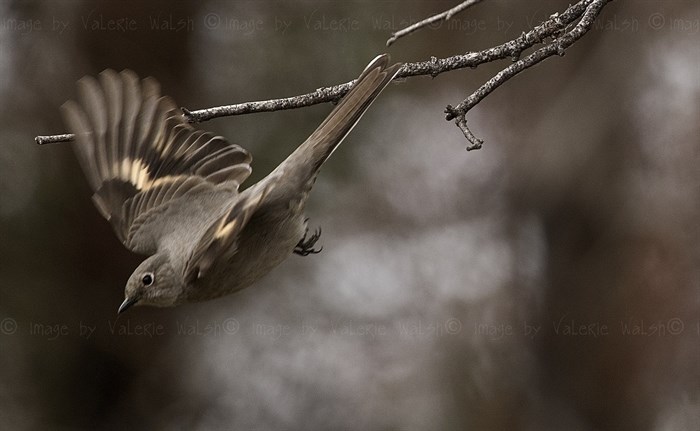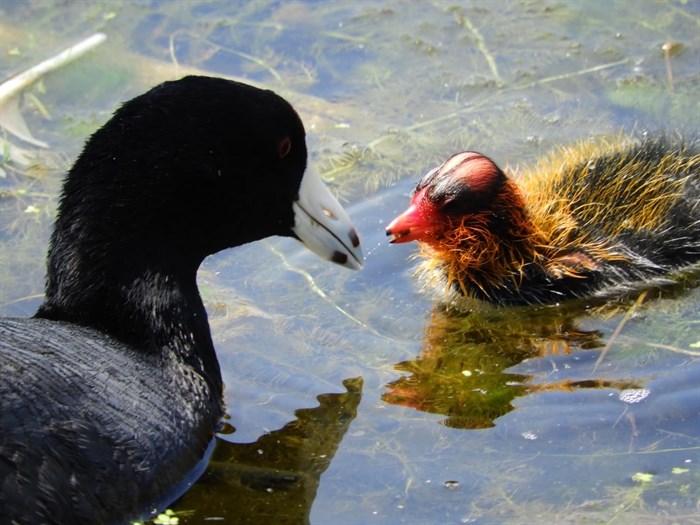Science
Arctic ice melt doesn't boost sea levels, so do we care? – FRANCE 24

Paris (AFP)
US government scientists reported Monday that the Arctic Ocean’s floating ice cover has shrivelled to its second lowest extent since satellite records began in 1979.
Until this month, only once in the last 42 years has Earth’s frozen skull cap covered less than four million square kilometres (1.5 million square miles).
The trend line is clear: sea ice extent has diminished 14 percent per decade over that period. The Arctic could see it’s first ice-free summer as early as 2035, researchers reported in Nature Climate Change last month.
But all that melting ice and snow does not directly boost sea levels any more than melted ice cubes make a glass of water overflow, which gives rise to an awkward question: who cares?
Granted, this would be bad news for polar bears, which are already on a glide path towards extinction, according to a recent study.
And yes, it would certainly mean a profound shift in the region’s marine ecosystems, from phytoplankton to whales.
But if our bottom-line concern is the impact on humanity, one might legitimately ask, “So what?”.
As it turns out, there are several reasons to be worried about the knock-on consequences of dwindling Arctic sea ice.
– Feedback loops –
Perhaps the most basic point to make, scientists say, is that a shrinking ice cap is not just a symptom of global warming, but a driver as well.
“Sea ice removal exposes dark ocean, which creates a powerful feedback mechanism,” Marco Tedesco, a geophysicist at Columbia University’s Earth Institute, told AFP.
Freshly fallen snow reflects 80 percent of the Sun’s radiative force back into space.
But when that mirror-like surface is replaced by deep blue water, about the same percentage of Earth-heating energy is absorbed instead.
And we’re not talking about a postage stamp area here: the difference between the average ice cap minimum from 1979 to 1990 and the low point reported today — more than 3 million km2 — is twice the size of France, Germany and Spain combined.
The oceans have already soaked up 90 percent of the excess heat generated by manmade greenhouse gases, but at a terrible cost, including altered chemistry, massive marine heatwaves and dying coral reefs.
And at some point, scientists warn, that liquid heat sponge may simply become saturated.
– Altering ocean currents –
Earth’s complex climate system includes interlocking ocean currents driven by wind, tides and something called the thermohaline circulation, which is itself powered by changes in temperature (“thermo”) and salt concentration (“haline”).
Even small changes in this Great Ocean Conveyor Belt — which moves between poles and across all three major oceans — can have devastating climate impacts.
Nearly 13,000 years ago, for example, as Earth was transitioning out of an ice age into the interglacial period that allowed our species to thrive, global temperatures abruptly plunged several degrees Celsius. They jumped back up again about 1,000 years later.
Geological evidence suggests a slowdown in the thermohaline circulation caused by a massive and rapid influx of cold, fresh water from the Artic region was partly to blame.
“The fresh water from melting sea ice and grounded ice in Greenland perturbs and weakens the Gulf Stream,” part of the conveyor belt flowing in the Atlantic, said Xavier Fettweis, a research associate at the University of Liege in Belgium.
“This is what allows western Europe to have a temperate climate compared to the same latitude in North America.”
The massive ice sheet atop Greenland’s land mass saw a net loss of more than half-a-trillion tonnes last year, all of it flowing into the sea.
Unlike sea ice, which doesn’t increase sea levels when it melts, runoff from Greenland does.
That record amount was due in part to warmer air temperatures, which have risen twice as fast in the Arctic as for the planet as a whole.
But it was also caused by a change in weather patterns, notably an increase in sunny summer days.
“Some studies suggest that this increase in anticyclonic conditions in the Arctic in summer results in part from the minimum sea ice extent,” Fettweis told AFP.
– Bears on thin ice –
The current trajectory of climate change and the advent of ice-free summers — defined by the UN’s IPCC climate science panel as under one million km2 — would indeed starve polar bears into extinction by century’s end, according to a July study in Nature.
“Human-caused global warming means that polar bears have less and less sea ice to hunt on in the summer months,” Steven Amstrup, lead author of the study and chief scientist of Polar Bears International, told AFP.
“The ultimate trajectory of polar bears with unabated greenhouse gas emissions is disappearance.”
© 2020 AFP
Science
Voyager 1 transmitting data again after Nasa remotely fixes 46-year-old probe – The Guardian


Earth’s most distant spacecraft, Voyager 1, has started communicating properly again with Nasa after engineers worked for months to remotely fix the 46-year-old probe.
Nasa’s Jet Propulsion Laboratory (JPL), which makes and operates the agency’s robotic spacecraft, said in December that the probe – more than 15bn miles (24bn kilometres) away – was sending gibberish code back to Earth.
In an update released on Monday, JPL announced the mission team had managed “after some inventive sleuthing” to receive usable data about the health and status of Voyager 1’s engineering systems. “The next step is to enable the spacecraft to begin returning science data again,” JPL said. Despite the fault, Voyager 1 had operated normally throughout, it added.
Launched in 1977, Voyager 1 was designed with the primary goal of conducting close-up studies of Jupiter and Saturn in a five-year mission. However, its journey continued and the spacecraft is now approaching a half-century in operation.
Voyager 1 crossed into interstellar space in August 2012, making it the first human-made object to venture out of the solar system. It is currently travelling at 37,800mph (60,821km/h).
The recent problem was related to one of the spacecraft’s three onboard computers, which are responsible for packaging the science and engineering data before it is sent to Earth. Unable to repair a broken chip, the JPL team decided to move the corrupted code elsewhere, a tricky job considering the old technology.
The computers on Voyager 1 and its sister probe, Voyager 2, have less than 70 kilobytes of memory in total – the equivalent of a low-resolution computer image. They use old-fashioned digital tape to record data.
The fix was transmitted from Earth on 18 April but it took two days to assess if it had been successful as a radio signal takes about 22 and a half hours to reach Voyager 1 and another 22 and a half hours for a response to come back to Earth. “When the mission flight team heard back from the spacecraft on 20 April, they saw that the modification worked,” JPL said.
Alongside its announcement, JPL posted a photo of members of the Voyager flight team cheering and clapping in a conference room after receiving usable data again, with laptops, notebooks and doughnuts on the table in front of them.
The Retired Canadian astronaut Chris Hadfield, who flew two space shuttle missions and acted as commander of the International Space Station, compared the JPL mission to long-distance maintenance on a vintage car.
“Imagine a computer chip fails in your 1977 vehicle. Now imagine it’s in interstellar space, 15bn miles away,” Hadfield wrote on X. “Nasa’s Voyager probe just got fixed by this team of brilliant software mechanics.
Voyager 1 and 2 have made numerous scientific discoveries, including taking detailed recordings of Saturn and revealing that Jupiter also has rings, as well as active volcanism on one of its moons, Io. The probes later discovered 23 new moons around the outer planets.
As their trajectory takes them so far from the sun, the Voyager probes are unable to use solar panels, instead converting the heat produced from the natural radioactive decay of plutonium into electricity to power the spacecraft’s systems.
Nasa hopes to continue to collect data from the two Voyager spacecraft for several more years but engineers expect the probes will be too far out of range to communicate in about a decade, depending on how much power they can generate. Voyager 2 is slightly behind its twin and is moving slightly slower.
In roughly 40,000 years, the probes will pass relatively close, in astronomical terms, to two stars. Voyager 1 will come within 1.7 light years of a star in the constellation Ursa Minor, while Voyager 2 will come within a similar distance of a star called Ross 248 in the constellation of Andromeda.
Science
iN PHOTOS: Nature lovers celebrate flora, fauna for Earth Day in Kamloops, Okanagan | iNFOnews | Thompson-Okanagan's News Source – iNFOnews


Photographers are sharing their favourite photos of flora and fauna captured in Kamloops and the Okanagan in celebration of Earth Day.
First started in the United States in the 70s, the special day on April 22 continues to be acknowledged around the globe. It’s a day to celebrate the planet and a reminder of the need for environmental conservation and sustainability, according to EarthDay.org.
These stunning nature photos show life in ponds and forests, in skies and on mountains, capturing the beauty and wonder of our local natural environments.
Area photographers shared some of their favourite finds and artistic captures. From frogs to flowers, the great outdoors is teeming with life.
If you have nature photos you want to share, send them to news@infonews.ca.








To contact a reporter for this story, email Shannon Ainslie or call 250-819-6089 or email the editor. You can also submit photos, videos or news tips to the newsroom and be entered to win a monthly prize draw.
We welcome your comments and opinions on our stories but play nice. We won’t censor or delete comments unless they contain off-topic statements or links, unnecessary vulgarity, false facts, spam or obviously fake profiles. If you have any concerns about what you see in comments, email the editor in the link above. SUBSCRIBE to our awesome newsletter here.


Science
An extra moon may be orbiting Earth — and scientists think they know exactly where it came from – Livescience.com


A fast-spinning asteroid that orbits in time with Earth may be a wayward chunk of the moon. Now, scientists think they know exactly which lunar crater it came from.
A new study, published April 19 in the journal Nature Astronomy, finds that the near-Earth asteroid 469219 Kamo’oalewa may have been flung into space when a mile-wide (1.6 kilometers) space rock hit the moon, creating the Giordano Bruno crater.
Kamo’oalewa’s light reflectance matches that of weathered lunar rock, and its size, age and spin all match up with the 13.6-mile-wide (22 km) crater, which sits on the far side of the moon, the study researchers reported.
China plans to launch a sample-return mission to the asteroid in 2025. Called Tianwen-2, the mission will return pieces of Kamo’oalewa about 2.5 years later, according to Live Science’s sister site Space.com.
“The possibility of a lunar-derived origin adds unexpected intrigue to the [Tianwen-2] mission and presents additional technical challenges for the sample return,” Bin Cheng, a planetary scientist at Tsinghua University and a co-author of the new study, told Science.
Related: How many moons does Earth have?
Kamo’oalewa was discovered in 2016 by researchers at Haleakala Observatory in Hawaii. It has a diameter of about 100 to 200 feet (approximately 30 to 60 meters, or about the size of a large Ferris wheel) and spins at a rapid clip of one rotation every 28 minutes. The asteroid orbits the sun in a similar path to Earth, sometimes approaching within 10 million miles (16 million km).
window.sliceComponents = window.sliceComponents || ;
externalsScriptLoaded.then(() => {
window.reliablePageLoad.then(() => {
var componentContainer = document.querySelector(“#slice-container-newsletterForm-articleInbodyContent-UG4KJ7zrhxAytcHZQxVzXK”);
if (componentContainer)
var data = “layout”:”inbodyContent”,”header”:”Sign up for the Live Science daily newsletter now”,”tagline”:”Get the worldu2019s most fascinating discoveries delivered straight to your inbox.”,”formFooterText”:”By submitting your information you agree to the Terms & Conditions and Privacy Policy and are aged 16 or over.”,”successMessage”:”body”:”Thank you for signing up. You will receive a confirmation email shortly.”,”failureMessage”:”There was a problem. Please refresh the page and try again.”,”method”:”POST”,”inputs”:[“type”:”hidden”,”name”:”NAME”,”type”:”email”,”name”:”MAIL”,”placeholder”:”Your Email Address”,”required”:true,”type”:”hidden”,”name”:”NEWSLETTER_CODE”,”value”:”XLS-D”,”type”:”hidden”,”name”:”LANG”,”value”:”EN”,”type”:”hidden”,”name”:”SOURCE”,”value”:”60″,”type”:”hidden”,”name”:”COUNTRY”,”type”:”checkbox”,”name”:”CONTACT_OTHER_BRANDS”,”label”:”text”:”Contact me with news and offers from other Future brands”,”type”:”checkbox”,”name”:”CONTACT_PARTNERS”,”label”:”text”:”Receive email from us on behalf of our trusted partners or sponsors”,”type”:”submit”,”value”:”Sign me up”,”required”:true],”endpoint”:”https://newsletter-subscribe.futureplc.com/v2/submission/submit”,”analytics”:[“analyticsType”:”widgetViewed”],”ariaLabels”:;
var triggerHydrate = function()
window.sliceComponents.newsletterForm.hydrate(data, componentContainer);
if (window.lazyObserveElement)
window.lazyObserveElement(componentContainer, triggerHydrate);
else
triggerHydrate();
}).catch(err => console.log(‘Hydration Script has failed for newsletterForm-articleInbodyContent-UG4KJ7zrhxAytcHZQxVzXK Slice’, err));
}).catch(err => console.log(‘Externals script failed to load’, err));
Follow-up studies suggested that the light spectra reflected by Kamo’oalewa was very similar to the spectra reflected by samples brought back to Earth by lunar missions, as well as to meteorites known to come from the moon.
Cheng and his colleagues first calculated what size object and what speed of impact would be necessary to eject a fragment like Kamo’oalewa from the lunar surface, as well as what size crater would be left behind. They figured out that the asteroid could have resulted from a 45-degree impact at about 420,000 mph (18 kilometers per second) and would have left a 6-to-12-mile-wide (10 to 20 km) crater.
There are tens of thousands of craters that size on the moon, but most are ancient, the researchers wrote in their paper. Near-Earth asteroids usually last only about 10 million years, or at most up to 100 million years before they crash into the sun or a planet or get flung out of the solar system entirely. By looking at young craters, the team narrowed down the contenders to a few dozen options.
The researchers focused on Giordano Bruno, which matched the requirements for both size and age. They found that the impact that formed Giordano Bruno could have created as many as three still-extant Kamo’oalewa-like objects. This makes Giordano Bruno crater the most likely source of the asteroid, the researchers concluded.
“It’s like finding out which tree a fallen leaf on the ground came from in a vast forest,” Cheng wrote on X, formerly known as Twitter.
Confirmation will come after the Tianwen-2 mission brings a piece of Kamo’oalewa back to Earth. Scientists already have a sample of what is believed to be ejecta from Giordano Bruno crater in the Luna 24 sample, a bit of moon rock brought back to Earth in a 1976 NASA mission. By comparing the two, researchers could verify Kamo’oalewa’s origin.
Editor’s note: This article’s headline was updated on April 23 at 10 a.m. ET.
-



 Health22 hours ago
Health22 hours agoSee how chicken farmers are trying to stop the spread of bird flu – Fox 46 Charlotte
-



 Investment23 hours ago
Investment23 hours agoOwn a cottage or investment property? Here's how to navigate the new capital gains tax changes – The Globe and Mail
-



 Science20 hours ago
Science20 hours agoOsoyoos commuters invited to celebrate Earth Day with the Leg Day challenge – Oliver/Osoyoos News – Castanet.net
-
News24 hours ago
‘A real letdown’: Disabled B.C. man reacts to federal disability benefit – Global News
-
News21 hours ago
Freeland defends budget measures, as premiers push back on federal involvement – CBC News
-



 Politics20 hours ago
Politics20 hours agoHaberman on why David Pecker testifying is ‘fundamentally different’ – CNN
-
Economy21 hours ago
The Fed's Forecasting Method Looks Increasingly Outdated as Bernanke Pitches an Alternative – Bloomberg
-
Business24 hours ago
Ottawa puts up $50M in federal budget to hedge against job-stealing AI – CP24








